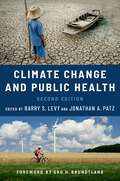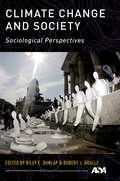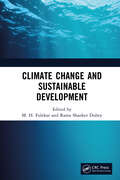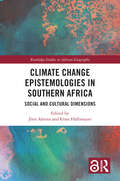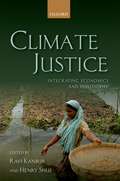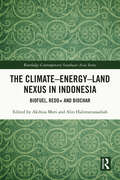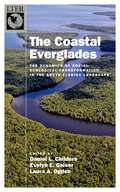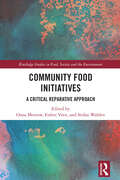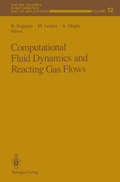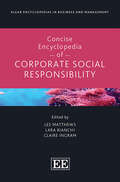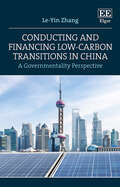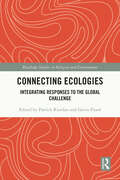- Table View
- List View
Climate Change and Public Health
This second edition of Climate Change and Public Health comprehensively covers the health impacts of climate change, including heat-related and respiratory disorders, vectorborne and waterborne diseases, malnutrition, mental disorders, and violence. It provides a thorough understanding of the policymaking process and energy, transportation, and agriculture policies for mitigation. It covers health adaptation, sustainable built environments, and nature-based solutions to address climate change. Finally, it describes ways of strengthening public and political support, including communicating the health relevance of climate change, building movements, and promoting climate justice.
Climate Change and Society: Sociological Perspectives
Climate change is one of the most critical issues of the twenty-first century, presenting a major intellectual challenge to both the natural and social sciences. While there has been significant progress in natural science understanding of climate change, social science analyses have not been as fully developed. Climate Change and Society breaks new theoretical and empirical ground by presenting climate change as a thoroughly social phenomenon, embedded in behaviors, institutions, and cultural practices. This collection of essays summarizes existing approaches to understanding the social, economic, political, and cultural dimensions of climate change. From the factors that drive carbon emissions to those which influence societal responses to climate change, the volume provides a comprehensive overview of the social dimensions of climate change. An improved understanding of the complex relationship between climate change and society is essential for modifying ecologically harmful human behaviors and institutional practices, creating just and effective environmental policies, and developing a more sustainable future. Climate Change and Society provides a useful tool in efforts to integrate social science research, natural science research, and policymaking regarding climate change and sustainability. Produced by the American Sociological Association's Task Force on Sociology and Global Climate Change, this book presents a challenging shift from the standard climate change discourse, and offers a valuable resource for students, scholars, and professionals involved in climate change research and policy.
Climate Change and Sustainable Development
Climate Change and Sustainable Development covers the climatic and atmospheric changes, greenhouse gases and their impact on eco-system, biodiversity, water resources, agriculture and food security, human health, extreme weather and environment across two sections. The mitigation and adaptation strategies involving sustainable development is also illustrated including efficient technology, renewable energy, developmental activities control and so forth. Nanotechnology for sustainable development, forest protection, environment, social and economic sustainability and climate change policy planning of international bodies like UNFCC, UNDP, Kyoto protocol is also included. Features: Covers climate change fundamentals and its impact on different ecosystems and natural disasters Describes non-renewable energy aspects like fossil fuel, coal, oil, natural gas and so forth Explores sustainable development in terms of environment, social and economic aspects Includes species diversity and loss, agriculture productivity, water resources scarcity, health and environmental, rise in sea level and coastal area submergence Illustrates scientific hybridization of traditional ecological knowledge for enhancing climate change adaptation This book is aimed at graduate students and researchers in engineering and public policy, engineering management, sustainable engineering, renewable energy engineering, environmental engineering, and sustainability.
Climate Change Epistemologies in Southern Africa: Social and Cultural Dimensions (Routledge Studies in African Geography)
This book investigates the social and cultural dimensions of climate change in Southern Africa, focusing on how knowledge about climate change is conceived and conveyed. Despite contributing very little to the global production of emissions, the African continent looks set to be the hardest hit by climate change. Adopting a decolonial perspective, this book argues that knowledge and discourse about climate change has largely disregarded African epistemologies, leading to inequalities in knowledge systems. Only by considering regionally specific forms of conceptualizing, perceiving, and responding to climate change can these global problems be tackled. First exploring African epistemologies of climate change, the book then goes on to the social impacts of climate change, matters of climate justice, and finally institutional change and adaptation. Providing important insights into the social and cultural perception and communication of climate change in Africa, this book will be of interest to researchers from across the fields of African studies, sociology, anthropology, philosophy, political science, climate change, and geography.
Climate Graph - Cool, temperate maritime: Shannon, Ireland (Large Print)
This is a graph showing temperature and precipitation over the period of a year in Shannon. There is a locator dot shown, which will be at the top left of the page when the image is the right way up. There are vertical bars indicating average monthly rainfall and a thick dashed line going across the page showing the average monthly temperature. On the left of the page is a vertical scale marked in degrees Centigrade starting from zero at the bottom. It is marked at every five degrees and labelled at every ten degrees. Running right across the page are fine horizontal grid lines. The thick dashed line representing the temperature can be found at the bottom left of the page sloping up and down to right. Across the bottom of the page are twelve labelled vertical bars showing the rainfall for each month of the year, starting with January on the left. To allow sufficient space, the braille labels are uncapitalised. At the far right of the page is a vertical scale of precipitation in millimetres, starting with zero at the bottom. This is marked every 25 mm and labelled every 50 mm.
Climate Graph - Cool, temperate maritime: Shannon, Ireland (UEB Contracted)
This is a graph showing temperature and precipitation over the period of a year in Shannon. There is a locator dot shown, which will be at the top left of the page when the image is the right way up. There are vertical bars indicating average monthly rainfall and a thick dashed line going across the page showing the average monthly temperature. On the left of the page is a vertical scale marked in degrees Centigrade starting from zero at the bottom. It is marked at every five degrees and labelled at every ten degrees. Running right across the page are fine horizontal grid lines. The thick dashed line representing the temperature can be found at the bottom left of the page sloping up and down to right. Across the bottom of the page are twelve labelled vertical bars showing the rainfall for each month of the year, starting with January on the left. To allow sufficient space, the braille labels are uncapitalised. At the far right of the page is a vertical scale of precipitation in millimetres, starting with zero at the bottom. This is marked every 25 mm and labelled every 50 mm.
Climate Graph - Cool, temperate maritime: Shannon, Ireland (UEB Uncontracted)
This is a graph showing temperature and precipitation over the period of a year in Shannon. There is a locator dot shown, which will be at the top left of the page when the image is the right way up. There are vertical bars indicating average monthly rainfall and a thick dashed line going across the page showing the average monthly temperature. On the left of the page is a vertical scale marked in degrees Centigrade starting from zero at the bottom. It is marked at every five degrees and labelled at every ten degrees. Running right across the page are fine horizontal grid lines. The thick dashed line representing the temperature can be found at the bottom left of the page sloping up and down to right. Across the bottom of the page are twelve labelled vertical bars showing the rainfall for each month of the year, starting with January on the left. To allow sufficient space, the braille labels are uncapitalised. At the far right of the page is a vertical scale of precipitation in millimetres, starting with zero at the bottom. This is marked every 25 mm and labelled every 50 mm.
Climate Graph- Mediterranean: Rome, Italy (Large Print)
This is a graph showing temperature and precipitation over the period of a year in Rome. There is a locator dot shown, which will be at the top left of the page when the image is the right way up. There are vertical bars indicating average monthly rainfall and a thick dashed line going across the page showing the average monthly temperature. On the left of the page is a vertical scale marked in degrees Centigrade starting from zero at the bottom. It is marked at every five degrees and labelled at every ten degrees. Running right across the page are fine horizontal grid lines. The thick dashed line representing the temperature can be found at the bottom left of the page sloping up and down to right. Across the bottom of the page are twelve labelled vertical bars showing the rainfall for each month of the year, starting with January on the left. To allow sufficient space, the braille labels are uncapitalised. At the far right of the page is a vertical scale of precipitation in millimetres, starting with zero at the bottom. This is marked every 25 mm and labelled every 50 mm.
Climate Graph- Mediterranean: Rome, Italy (UEB Contracted)
This is a graph showing temperature and precipitation over the period of a year in Rome. There is a locator dot shown, which will be at the top left of the page when the image is the right way up. There are vertical bars indicating average monthly rainfall and a thick dashed line going across the page showing the average monthly temperature. On the left of the page is a vertical scale marked in degrees Centigrade starting from zero at the bottom. It is marked at every five degrees and labelled at every ten degrees. Running right across the page are fine horizontal grid lines. The thick dashed line representing the temperature can be found at the bottom left of the page sloping up and down to right. Across the bottom of the page are twelve labelled vertical bars showing the rainfall for each month of the year, starting with January on the left. To allow sufficient space, the braille labels are uncapitalised. At the far right of the page is a vertical scale of precipitation in millimetres, starting with zero at the bottom. This is marked every 25 mm and labelled every 50 mm.
Climate Graph- Mediterranean: Rome, Italy (UEB Uncontracted)
This is a graph showing temperature and precipitation over the period of a year in Rome. There is a locator dot shown, which will be at the top left of the page when the image is the right way up. There are vertical bars indicating average monthly rainfall and a thick dashed line going across the page showing the average monthly temperature. On the left of the page is a vertical scale marked in degrees Centigrade starting from zero at the bottom. It is marked at every five degrees and labelled at every ten degrees. Running right across the page are fine horizontal grid lines. The thick dashed line representing the temperature can be found at the bottom left of the page sloping up and down to right. Across the bottom of the page are twelve labelled vertical bars showing the rainfall for each month of the year, starting with January on the left. To allow sufficient space, the braille labels are uncapitalised. At the far right of the page is a vertical scale of precipitation in millimetres, starting with zero at the bottom. This is marked every 25 mm and labelled every 50 mm.
Climate Justice: Integrating Economics and Philosophy
Climate justice requires sharing the burdens and benefits of climate change and its resolution equitably and fairly. It brings together justice between generations and justice within generations. In particular it requires that attempts to address justice between generations through various interventions designed to curb greenhouse emissions today do not end up creating injustice in our time by hurting the currently poor and vulnerable. The United Nations Sustainable Development Goals (SDGs) summit in September 2015, and the Conference of Parties (COP) to the Framework Convention on Climate Change in Paris in December 2015, brought climate change and its development impact centre stage in global discussions. In the run up to Paris, Mary Robinson, former President of Ireland and UN Secretary General's Special Envoy for Climate Change, instituted the Climate Justice Dialogue "to mobilize political will and creative thinking to shape an ambitious and just international climate agreement in 2015". The editors of this volume, an economist and a philosopher, served on the High Level Advisory Committee of the Climate Justice Dialogue. They noted the overlap and mutual enforcement between the economic and philosophical discourses on climate justice. But they also noted the great need for these strands to come together to support the public and policy discourse. Climate Justice: Integrating Economics and Philosophy is the result. Bringing together contributions from economists and philosophers, Climate Justice illustrates the different approaches, how they overlap and interact, and what they have already learned from each other and might still have to learn.
Climate-Resilient Agriculture: A Molecular Perspective
Developing climate-smart crops is vital to securing food security around the world. This new book discusses the state-of-the-art technologies that can help to mitigate plant abiotic stresses in cultivated crops. It covers the current aspects of climate-resilience agriculture, including the crucial physiological, biochemical, and molecular aspects of cultivated crops under stress conditions, which play a pivotal role in developing climate-smart crops. The volume explores breeding, omics, genetic engineering, bioengineering of metabolic pathways, artificial intelligence, and more.Key features: Addresses the current and future challenges of climate changes on food security Details the impact of different biotic, abiotic stresses, along with their interactions and effect on crop plants in climate-changing scenarios Gives a comprehensive account of molecular mechanisms associated with different stresses in crop plants Discusses advances in breeding and biotechnological techniques to tackle the different stresses in challenging climatic fluctuations Highlights various emerging approaches and technologies currently being used in developing climate-smart crops Provides success stories of crop improvement against the different stresses.
The Climate–Energy–Land Nexus in Indonesia: Biofuel, REDD+ and biochar (Routledge Contemporary Southeast Asia Series)
This book extends the framework of the climate-energy-land nexus to elucidate political, economic, social, and institutional factors and causal mechanisms that stringent climate targets bring about, rather than mitigate a disproportional heavy burden on the forest sector in Indonesia. Assessing climate, energy, agricultural, forest, and transmigration policies, and REDD+ and biochar solutions through a multidisciplinary approach, ranging from biological, agricultural, technological, economic, and institutional lenses, the book identifies the political-economic and socio-technical regimes that cause the crosssectoral transfer of responsibility for greenhouse gas emissions to palm-oil-based biofuel, imposing an excess burden on the forest sector and accelerating indirect land-use change. It also proposes possible countermeasures for agricultural and forest sectors, reconfirming that technical applications and integrated policymaking should trigger the socioeconomic changes that will make transformative change happen in Indonesia. As an analysis of the success, or otherwise, of stringent climate targets, policies, and technological and non-technological measures on the reduction of greenhouse gases, this book will be of great interest to students and scholars in the fields of environment & sustainability, Asian studies, energy, environment and agriculture, forestry, and agriculture & environmental sciences. It will also appeal to practitioners and policymakers tackling net-zero emissions and land and forest governance.
The Coastal Everglades: The Dynamics of Social-Ecological Transformation in the South Florida Landscape (The Long-Term Ecological Research Network Series)
The Coastal Everglades presents a broad overview and synthesis of research on the coastal Everglades, a region that includes Everglades National Park, adjacent managed wetlands, and agricultural and urbanizing communities. Contributors for this volume are all collaborators on the Florida Coastal Everglades Long-Term Ecological Research Program (FCE LTER). The FCE LTER began in 2000 with a focus on understanding key ecosystem processes in the coastal Everglades, while also developing a platform for and linkages to related work conducted by an active and diverse Everglades research community. The program is based at Florida International University in Miami, but includes scientists and students from numerous other universities as well as staff scientists at key resource management agencies, including Everglades National Park and the South Florida Water Management District. Though the Everglades landscape spans nearly a third of the State of Florida, the focus on the coastal Everglades has allowed the contributors to examine key questions in social-ecological science in the context of ongoing restoration initiatives. As this book demonstrates, the long-term research of the FCE LTER has facilitated a better understanding of the roles of sea level rise, water management practices, urban and agricultural development, and other disturbances, such as fires and storms, on the past and future dynamics of this unique coastal environment. By comparing properties of the Everglades with other subtropical and tropical wetlands, the book challenges ideas of novelty while revealing properties of ecosystems at the ends of gradients that are often ignored. It also provides insights from, and encouragement for, long-term collaborative studies that inform resource management in similarly threatened coastal wetland landscapes.
Collective Sustainable Consumption: The Case of Poland (ISSN)
In the face of climate change and resulting environmental and social crises, sustainable consumption has become a widely discussed issue and a key plank of the UN’s Sustainable Development Goals (SDGs). The majority of the sustainable consumption research uses the SDG framework, but this only serves to reinforce an individualistic, efficiency-based approach and it does not sufficiently cover the specific situation of transition economies. In contrast, this volume promotes a collective approach to sustainable consumption, and combines general theoretical issues with empirical examples from the Polish economy. The first part of the book presents a theoretical approach to collective consumption which has the core concepts of justice and human nature at its heart. This approach emphasises the role of collective rationality and categorises aspects of sustainable consumption as a common and public good. The second part investigates diversified aspects of sustainability, including socio-economic inequalities as barriers to sustainable consumption, consumer sovereignty in the context of current legal regulations, and the impact on employees of changes to the types and conditions of work. It also examines the sharing economy and the legal conditions of its development. The third part adopts a political perspective focusing on the state policies enhancing the role of investment in public goods, analyses photovoltaic programmes which promote prosumption and indicates challenges to sustainability faced by many countries such as the energy crisis, sustainable finance, and cooperative platforms.This book will be of great interest to researchers and scholars interested in sustainability and consumption issues in economics, management, law, public administration, and political science.
Combating Climate Change with Section 115 of the Clean Air Act: Law and Policy Rationales
Editor Michael Burger brings together a comprehensive assessment of how one statutory provision – Section 115 of the Clean Air Act, “International Air Pollution” – provides the executive branch of the U.S. government with the authority, procedures, and mechanisms to work with the states and private sector to take national climate action. This collaborative effort reflects the most current thinking on Section 115 and how it relates to the Paris Agreement , the U.S. Supreme Court, and U.S. politics. The contributors dive deep into the key implementation issues EPA, the states and industry would need to address. Federal policymakers in a new presidential administration could use this book as a foundation for developing a national policy regulating greenhouse gas emissions. The book also provides detailed law and policy analyses for environmental lawyers and policy professionals, key to understanding the practice of climate law and policy in the U.S.
Combined Roof-Bolting Systems of Mine Workings
The basic principles of geomechanical processes occurring in mine workings during the extraction of minerals are discussed in this monograph. Particular attention is paid to the support system, specifically to the various roof-bolt and frame support designs, and also to the modern means providing resource-saving conditions for ensuring mine workings sustainability. The basic principles of the computing experiment performance at the modelling of geomechanical processes are also presented and the stress-strain state of "rock massif – mine working support" systems are investigated. Finally, the results of field studies are discussed and illustrated. Modern studies are presented in this work, the advanced support systems are introduced and the solution to the problem of low-cost rock pressure control in mine workings is described. Further the unique study in the thin-layer massif of weak rocks is conducted and the technical and economic aspects of mine workings maintenance during rocks heaving are described. The book will be of interest to scientists in research and design organizations in the mining sector, engineers and technological workers in mines, as well as university academics and students.
Communities and Museums in the 21st Century: Shared Histories and Climate Action (ICOM Advances in Museum Research)
Communities and Museums in the 21st Century brings together innovative, multidisciplinary perspectives on contemporary museology and participatory museum practice that contribute to wider debates on museum communities, heritage, and sustainability. Set within the context of globalisation and decolonisation, this book draws upon bi-regional research that will enrich our understanding of the complex relationships between Europe, Latin America and the Caribbean through museum studies and practice. Chapters reflect upon the role of museums in defining community identities; the importance of young people’s participation and intergenerational work for sustainability; the role of museums in local development; and community-based museums and climate change. Contributors examine these issues through the lens of museum partnerships and practices, as well as testing the continued relevance of the notion of ‘integral museum’ and its relatives in the form of ecomuseums. With its focus on regional museums in Latin America and Caribbean, this book highlights how the case studies promote greater intercultural dialogue, global understanding and social cohesion. It also demonstrates how the methodology can be adapted to other communities who are facing the perils of climate change and unsustainable forms of development. Communities and Museums in the 21st Century proposes creative and sustainable strategies relevant to a globalised future. With its focus on global societal challenges, this book will appeal to museologists and museum practitioners, as well as those working in heritage studies, cultural studies, memory studies, art history, gender studies, and sustainable development.
Community Food Initiatives: A Critical Reparative Approach (Routledge Studies in Food, Society and the Environment)
This book examines a diverse range of community food initiatives in light of their everyday practices, innovations, and contestations. While community food initiatives aim to tackle issues like food security, food waste, or food poverty, it is a cause for concern for many when they are framed as the next big "solution" to the problems of the current industrialised food system. They have been critiqued for being too neoliberal, elitist, and localist; for not challenging structural inequalities (e.g. racism, privilege, exclusion, colonialism, capitalism); and for reproducing these inequalities within their own contexts. This edited volume examines the everyday realities of community food initiatives, focusing on both their hopes and their troubles, their limitations and failures, but also their best intentions, missions, and models, alongside their capacity to create hope in difficult times. The stories presented in this book are grounded in contemporary theoretical debates on neoliberalism, diverse economies, food justice, community and inclusion, and social innovation, and help to sharpen these as conceptual tools for interrogating community food initiatives as sites of both hope and trouble. The novelty of this volume is its focus on the everyday doings of these initiatives in particular places and contexts, with different constraints and opportunities. This grounded, relational, and place-based approach allows us to move beyond more traditional framings in which community food initiatives are either applauded for their potential or criticized for their limitations. It enables researchers and practitioners to explore how community food initiatives can realize their potential for creating alternative food futures and generates innovative pathways for theorising the mutual interplay of food production and consumption. This volume will be of great interest to students and scholars of critical food studies, food security, public health, and nutrition as well as human geographers, sociologists, and anthropologists with an interest in food.
Computational Fluid Dynamics and Reacting Gas Flows (The IMA Volumes in Mathematics and its Applications #12)
This IMA Volume in Mathematics and its Applications COMPUTATIONAL FLUID DYNAMICS AND REACTING GAS FLOWS is in part the proceedings of a workshop which was an integral part of the 1986-87 IMA program on SCIENTIFIC COMPUTATION. We are grateful to the Scientific Committee: Bjorn Engquist (Chairman), Roland Glowinski, Mitchell Luskin and Andrew Majda for planning and implementing an exciting and stimulating year-long program. We especially thank the Workshop Organizers, Bjorn Engquist, Mitchell Luskin and Andrew Majda, for organizing a workshop which brought together many of the leading researchers in the area of computational fluid dynamics. George R. Sell Hans Weinberger PREFACE Computational fluid dynamics has always been of central importance in scientific computing. It is also a field which clearly displays the essential theme of interaction between mathematics, physics, and computer science. Therefore, it was natural for the first workshop of the 1986- 87 program on scientific computing at the Institute for Mathematics and Its Applications to concentrate on computational fluid dynamics. In the workshop, more traditional fields were mixed with fields of emerging importance such as reacting gas flows and non-Newtonian flows. The workshop was marked by a high level of interaction and discussion among researchers representing varied "schools of thought" and countries.
Concise Encyclopedia of Corporate Social Responsibility (Elgar Encyclopedias in Business and Management series)
This Concise Encyclopedia is an interdisciplinary overview of the field of Corporate Social Responsibility (CSR). It not only incorporates well-established concepts proffered by highly influential voices, but also captures the perspectives of tomorrow.The entries present some of the main topics gravitating around CSR and its theoretical evolution, while recognising how the framework has spread out into different academic fields. This Concise Encyclopedia helps to update CSR scholarship in line with developments within the broader discourse on the responsibilities of business, with new reflections on well-established concepts.Presenting a state-of-the-art discussion on the evolution of and future for CSR, this Concise Encyclopedia will serve as a significant reference point for both scholars and students of Business Ethics, Business and Human Rights and Corporate Sustainability. The depth of discussion throughout the Concise Encyclopedia will be useful for academics, practitioners, and policymakers alike.Key Features:46 accessible and fully-referenced entriesContributions from leading scholars and academics in the fieldWritten in a critical and reflective style, with entries grounded in ongoing debates on CSRRecognition of Business and Human Rights (BHR) as an emergent theme within CSR, with entries on modern slavery and workers’ rights
Conducting and Financing Low-carbon Transitions in China: A Governmentality Perspective
Utilizing a governmentality lens, this timely book offers an explanation for China’s decarbonization performance in the early 21st century. Le-Yin Zhang investigates one of the most ambitious governing projects in history, analyzing the political rationalities of Chinese leaders for decarbonization and the governing techniques and technologies at multiple levels of governance. Demonstrating the potential of combining the use of juridical, administrative and governmental powers, Zhang holistically considers the success of the state in instigating low-carbon transitions in China and mitigating climate disaster. The book provides an in-depth exploration of the art of greening the Chinese financial system and how this links to a wider formulation of carbon governmentality, highlighting the rise of the carbon governmental state through a range of governmental technologies. Engaging with a wide range of primary data from both national and local levels, the author uncovers profound lessons in low-carbon transitions for other states in the making of a carbon neutral world. This cutting-edge book offers key insights for scholars and researchers of environmental governance and its importance in mitigating climate change, particularly those with a key focus on Chinese climate policy. It will also benefit government officials, researchers and consultants investigating potential avenues for low-carbon transition and climate action.
Connecting Ecologies: Integrating Responses to the Global Challenge (Routledge Studies in Religion and Environment)
Connecting Ecologies focuses on the environmental aspects of Pope Francis’ encyclical Laudato Si’ and the challenge to care for our common home. It considers how best to devise and implement the new societal models needed to tackle the ecological problems facing the world today. The book addresses the need for and complexity of an integral ecology, one that looks not only at physical and biological processes but also allows for the contributions of theology, philosophy, spirituality, and psychology, including the implications for the human and social sciences. The contributions document four categories of resonances, resources, requirements, and responses evoked by a reading of Laudato Si’ and include consideration of other faith traditions. They reflect on how care for our common home motivates people in different places, cultures, and professions to cooperate for myriad goods in common. The volume is particularly relevant for scholars working in religious studies and theology with an interest in ecology, the environment, and the Anthropocene.
Conservation Paleobiology: Science and Practice
In conservation, perhaps no better example exists of the past informing the present than the return of the California condor to the Vermilion Cliffs of Arizona. Extinct in the region for nearly one hundred years, condors were successfully reintroduced starting in the 1990s in an effort informed by the fossil record—condor skeletal remains had been found in the area’s late-Pleistocene cave deposits. The potential benefits of applying such data to conservation initiatives are unquestionably great, yet integrating the relevant disciplines has proven challenging. Conservation Paleobiology gathers a remarkable array of scientists—from Jeremy B. C. Jackson to Geerat J. Vermeij—to provide an authoritative overview of how paleobiology can inform both the management of threatened species and larger conservation decisions. Studying endangered species is difficult. They are by definition rare, some exist only in captivity, and for those still in their native habitats any experimentation can potentially have a negative effect on survival. Moreover, a lack of long-term data makes it challenging to anticipate biotic responses to environmental conditions that are outside of our immediate experience. But in the fossil and prefossil records—from natural accumulations such as reefs, shell beds, and caves to human-made deposits like kitchen middens and archaeological sites—enlightening parallels to the Anthropocene can be found that might serve as a primer for present-day predicaments. Offering both deep-time and near-time perspectives and exploring a range of ecological and evolutionary dynamics and taxa from terrestrial as well as aquatic habitats, Conservation Paleobiology is a sterling demonstration of how the past can be used to manage for the future, giving new hope for the creation and implementation of successful conservation programs.
Contextual Heterogeneity in Entrepreneurship Research: Frontiers in European Entrepreneurship Research (Frontiers in European Entrepreneurship series)
This insightful book explores the importance and influence of contextual heterogeneity in the field of entrepreneurship research, illuminating the circumstances, conditions or environments that may enable or constrain entrepreneurship. Expert contributors present the results of empirical studies in a wide variety of contexts, describing their depth and meaning both for entrepreneurship research and practice. Chapters illustrate a range of topics and research methods, including business model innovation in start-up companies, the challenges and opportunities for women entrepreneurs in STEM, and the use of technology signalling in explaining the performance of immigrant entrepreneurship in market economies. Presenting new scientific evidence in the field, together with research-informed policy and practical implications, the book demonstrates that a multitude of research approaches must be used to reflect the multi-dimensional nature of context in entrepreneurship. Warning against simplistic interpretations and superficial conclusions of research, this book will prove to be an invaluable resource for scholars and students of entrepreneurship. Its use of empirical studies will also be beneficial for practitioners in this field.
